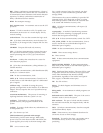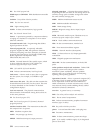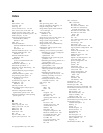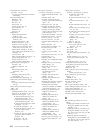
Glossary of Terms and Abbreviations
This glossary includes terms and definitions from:
v The American National Dictionary for Information
Systems, ANSI X3.172-1990, copyright 1990 by
the American National Standards Institute
(ANSI). Copies may be purchased from the
American National Standards Institute, 1430
Broadway, New York, New York 10018. The
symbol (A) after the definition identifies
definitions.
v The Information Technology Vocabulary developed
by Subcommittee 1, Joint Technical Committee
1, of the International Organization for
Standardization and the International
Electrotechnical Committee (ISO/IEC
JTC1/SC1). Definitions of published parts of
this vocabulary are identified by the symbol (I)
after the definition. Definitions taken from draft
international standards, committee drafts, and
working papers being developed by ISO/IEC
JTC1/SC1 are identified by the symbol (T) after
the definition, indicating that final agreement
has not yet been reached among participating
National Bodies of SC1.
ac. Alternating current.
ACR. In data communications, abbreviation for
abandon call and retry.
AER. Asynchronous error report.
APAR. See authorized program analysis report.
APPN. See advanced peer-to-peer networking (APPN).
AROS. Alterable read-only storage.
ASCII. See American National Standard Code for
Information Interchange.
ASP. See auxiliary storage pool.
advanced program-to-program communications
(APPC). Data communications support that allows
programs on an iSeries server to communicate with
programs on other systems having compatible
communications support. APPC on the iSeries server
provides an application programming interface to the
SNA LU type 6.2 and node type 2.1 architectures.
alternate installation device. A tape device that is
used to load Licensed Internal Code (LIC) from the
tape to the load source disk unit during a restore or
installation operation. The alternate installation device
can be on a different bus unit or on a different
input/output processor (IOP) than the load source disk
unit. See also installation device.
alternate installation IPL. A special type of
installation (D) IPL in which the system uses the
installation device to IPL itself, then uses the alternate
installation device to copy the LIC to the load source
disk unit from. See also alternate installation device.
alternate installation media. Media (tape) that
contains the Licensed Internal Code (LIC) that will be
installed or restored on a system during an alternate
installation IPL (type D IPL). It is placed in an alternate
installation device.
American National Standards Institute (ANSI). An
organization that is sponsored by the Computer and
Business Equipment Manufacturers Association for
establishing voluntary industry standards.
American National Standard Code for Information
Interchange (ASCII). The code that was developed by
the American National Standards Institute for
information exchange among data processing systems,
data communications systems, and associated
equipment. The ASCII character set consists of 7-bit
control characters and symbolic characters, plus one
parity-check bit.
attended IPL. An initial program load that allows you
to change configuration options from the display to
manually control how the system does an IPL and how
the system runs.
authorized program analysis report (APAR). A
request for correction of a defect in a release of an
IBM-supplied program.
auxiliary storage pool (ASP). A group of disk units
that are defined from the auxiliary storage devices. See
also system ASP.
BAT. See basic assurance test.
BBBB Ccbb. Addressing scheme for the bus (BBBB),
card (Cc), and board (bb).
bis. In data communications, secondary (as in V.27
bis, the identifier assigned by the International
Telecommunications Union (ITU)). There is an ITU
V.27, ITU V.27 bis (where V.27 bis is basically a
secondary method of achieving V.27), and ITU V.27 ter
(where ter = tertiary). This term is also used with X.21
and V.25.
bpi. Bits per inch.
Bpi. Bytes per inch.
© Copyright IBM Corp. 1997, 2002 325


















